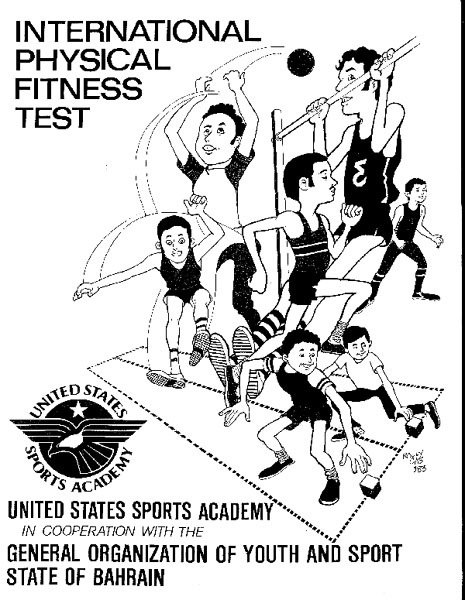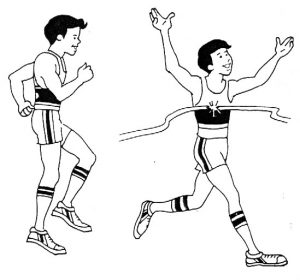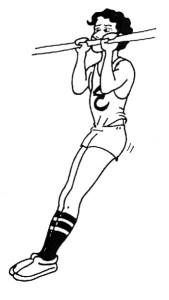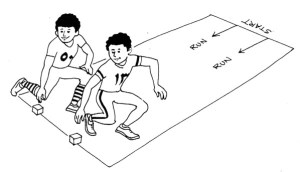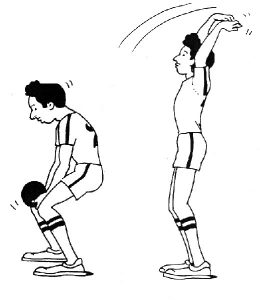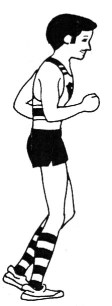How Teens & Adults Feel About Physical Activity & Physical Education: A Survey Conducted for NASPE
The lack of physical activity among Americans of all ages is so critical that it is considered to be a major health risk. Recently, the New England Journal of Medicine reported that girls become so sluggish in their teenage years that many barely move at all. African American girls are even more sedentary than whites, according to the report, and this sets the stage for a lifetime of obesity and associated chronic illnesses like high blood pressure and diabetes.
The 1996 Surgeon General’s Report on Physical Activity and Health reports that Americans become increasingly less active with each year of age. Research links inactivity among children to sedentary living among adults. Inactivity and poor diet cause at least 300,000 deaths a year in the United States, more than result from infectious disease, firearms, motor vehicles, and illicit drug use combined. Physical activity (or more directly, inactivity) is a risk factor in many diseases: stroke, heart disease, high blood pressure, osteoporosis, various cancers, diabetes, depression, obesity, and more.
Survey Methodology
The survey, which was conducted by Opinion Research Corp. International of Princeton, New Jersey, is based on interviews with a nationally representative sample of 1,021 adults (18 years of age and older, 50% male, 50% female) and 500 teens ages 12-17. The margin of error for the adult sample is ± 3 percentage points; when broken into subgroups (those with and without children in the household), the margin of error is ± 6 percentage points. The margin of error for the teen sample is ± 4 percentage points. All interviewing was done August 1-4, 2002. The survey was funded with an unrestricted grant from the National Soft Drink Association.
Here are the survey’s major findings concerning adults’ and teens’ beliefs.
Major Findings Concerning Adult Physical Activity
Getting Enough Physical Activity to Maintain a Healthy Lifestyle
The majority of adults (59%) feel that they are getting enough physical activity to maintain a healthy lifestyle. Men are more likely than women to feel they are getting enough physical activity to maintain a healthy lifestyle (65% vs. 53%). Adults outside metropolitan areas (65%) are more apt than adults who live in metropolitan areas (57%) to believe they are getting enough daily physical activity.
Nearly 9 in 10 (88%) American adults report that they exercise for a period of at least 30 min per week, on an average 3.9 days per week. Men are more likely than women to get at least some weekly exercise (91% vs. 84%). Adults under 55 are more likely than older adults to report having at least some weekly exercise (nearly 90% for under 55 vs. 82% for those 55 and older).
Things Which Prevent Adults from Getting Enough Physical Activity
Most adults who reported they do not get enough physical activity tended to say that work (23%), not having enough time (18%), health problems (12%), or lack of interest or motivation (12%) prevented their being physically active.
Importance of Physical Activity
Most adults (73%) state that health is the reason that physical activity is important. A number of adults also mention weight (16%), attitude (10%), and appearance (9%) as additional important reasons. Females are significantly more likely than males to mention health (77% vs. 68%) and weight (19% vs. 13%) as top reasons that physical activity is important.
Improving Job Performance
Almost 9 out of 10 adults (88%) feel that being physically fit will help them improve their job performance. Among adults aged 35-54, 91% feel their job performance is positively affected by being fit; among younger adults, those aged 18-34, 86% share that opinion.
Adults who currently have children in their household are significantly more likely than adults not sharing a household with children to believe that job performance improves with physical fitness (93% vs. 85%). Of those who believe that job performance improves with physical fitness, 93% cite “gives you more energy” as the reason for improved performance, while 85% cite “gives you greater mental alertness,” 83% choose “reduces stress,” and 60% choose “allows better time management.”
Women are much more likely than men to report feeling that, where employment is concerned, physical fitness reduces stress (86% vs. 76%) or allows better time management (65% vs. 55%).
Television Viewing and Personal Computer Usage
On average, American adults watch 2.2 hr of television per day. Women average 2.4 hr per day of television viewing, significantly more than men’s average 2.0 hr daily. Adults 55 years and over are more likely to watch 5 hr or more per day, when compared to adults ages 35-54 (15% vs. 7%) and adults ages 18-34 (15% vs. 8%). In addition, overall, adults are spending almost 2 hr (1.7 hr) each day using a personal computer for Internet browsing, electronic chat, games, and school research.
Major Findings Concerning Physical Activity of Children Sharing Surveyed Adults’ Households
Getting Enough Physical Activity to Maintain a Healthy Lifestyle
Three quarters (76%) of adults having children ages 6-17 in their households feel that their children are getting enough daily physical activity to maintain a healthy lifestyle.
School-Based Physical Education
Adults perceive that their children complete school-based physical education classes on 3.4 days per school week. About three quarters (74%) of adults having children ages 6-17 in their household feel that they have a good understanding of the physical education curriculum at the schools their children attend, and a majority of these adults (84%) perceive their children’s physical education classes in a positive light.
Nearly three fourths (73%) of American adults who have 6- to 17-year-old children in the household believe that physical education furthers the development of learning capabilities in other subject areas like math, reading, and science; more women than men hold this belief (80% vs. 65%). Adults in households with income below $25,000 are more likely (85%) than those in households with income at or above $25,000 (72%) to report feeling that physical education aids in learning other school subjects. Adults in the North Central region are most likely (82%) to agree that their child’s physical education contributes to the development of other learning capabilities.
Some reasons adults give for believing that physical education furthers their child’s development in other school subjects are that physical education “makes child more alert/aware” (26%); enables their child to better “focus/concentrate” (14%); “gives/increases energy” (9%); teaches child to “work with others” (6%); reduces stress experienced by child (6%); involves the use of math (i.e., in sports) (6%), makes child “more healthy” (5%); and provides a break from other tasks, important since children need to move around (5%).
Adults age 55 or more are those most inclined to feel that their child’s participation in physical education improves mental function overall; 71% of adults in this group believe so, while 54% of adults age 35-54 and 51% of adults age 18-34 believe so. Adults who reside in larger households (3 or more persons) are more likely to state that a child’s participation in physical education improves mental function overall (55%), as compared to adults who live alone with a child (40%).
Furthermore, adults with some college education are likelier than those without any college education to hold their child’s physical education important for reasons of health or increased energy. Five percent of the latter group (no college) cited one of those two reasons, while 13% of the former group cited health and 12% of the former group cited increased energy. It is interesting to compare these proportions with results broken down by income: Among adults with household incomes of $50,000 or more, 13% cited health and 18% cited energy, while among those with household incomes between $25,000 and $49,999, 9% cited health and 2% cited energy, and among those at less than $25,000, 9% cited health and 0% cited energy.
Daily Non-School-Based Physical Activity of Child
Surveyed adults having children in their households between 6 and 17 years of age report that their children spend an average of 2.5 hr daily in after-school physical activity. Most parents (72%) say they encourage the child’s physical activity either all the time or frequently; 7% say they infrequently or never encourage the child’s physical activity.
Broken down by region, significantly more adults in the West (53%) encourage children’s physical activity all of the time than in the Northeast (30%) or North Central (28%) regions.
Things Which Prevent Child from Getting Enough Physical Activity
Television (42%) and computers and video games (41%) are the barriers to child’s physical activity most commonly cited by adults whose households include a child. Lack of interest or motivation (29%), too much homework (28%), and lack of access to safe facilities (21%) follow closely behind.
On average, the child of a parent surveyed for this study spends 2.2 hr each day watching television, 1.9 hr each day reading or doing homework, 1.4 hr daily on the computer/Internet, 1.2 hr playing video games, and 1.1 hr daily talking on the telephone.
Physical Activity and Child’s Self-Esteem
The majority of the surveyed adults having children ages 6-17 (84%) feel that participation in physical activity (e.g., a sport) has a positive effect on a child’s self-esteem. A particularly high percentage (94%) of adults in the Northeast region affirms the connection between physical activity and self-esteem. Furthermore, an overwhelming majority (85%) of the adults with children 6-17 believe that participation in sports or physical activity minimizes a child’s ability to get into trouble.
Attitude Toward Physical Activity and Physical Education
Nearly 8 of 10 parents (79%) feel that their own attitudes concerning physical activity in turn affect their children’s attitudes toward physical activity. A larger proportion of the relatively affluent parents surveyed (household income of $50,000 or more) agree (86%) that their own attitudes affect the children’s attitudes when it comes to physical activity; a smaller proportion of relatively non-affluent parents (household income under $25,000) agreed (67%).
Similarly, 8 in 10 parents (77%) feel that their own attitudes towards physical education in turn affect the attitudes of their children toward physical education.
Major Findings Concerning Teen Physical Activity
Getting Enough Physical Activity to Maintain a Healthy Lifestyle
A large majority of the 12- to 17-year-olds surveyed (84%) say they obtain enough daily physical activity to maintain a healthy lifestyle. Younger teens (those age 12-14) are more likely than older teens (those age 15-17) to say they get enough physical activity every day (88% vs. 81%). Among teens, males are more likely than females to say their daily physical activity is sufficient to maintain a healthy lifestyle (88% vs. 81%).
When asked what person could be most helpful to them in terms of becoming more physically active, few teens cite their doctors (4%), their teachers (5%), or celebrities (3%). Instead, the surveyed teens say that friends, parents, and professional athletes could help them increase their physical activity (56%, 18%, and 11%, respectively). Older teens are more likely than younger ones to think of friends as persons most helpful in increasing physical activity (60% for older teens vs. 51% among 12- to 14-year-olds).
Daily After-School Physical Activity of Teens
Slightly more than half of teens (59%) participate in organized team or club sports after school. Teens in the Northeast region participate in such afterschool programs at a rate of 70%, while teens in the South and West participate at a rate of 56% and 49%, respectively.
School-Based Physical Education
An overwhelming majority of teens (92%) feel they should receive some type of daily physical education at school. This opinion was expressed by younger teens (age 12-14) at a rate of 96% and by older teens (age 15-17) at a rate of 87%.
Of the surveyed teens, half (50%) say that they should have school-based physical education classes five days a week; only 3% of the teens feel that school-based physical education should take place one day a week. Teens in the Northeast region are much less likely than teens in other regions to state that they should receive physical education five days a week.
More than three quarters of all teens (78%) classify their school-based physical education experiences as very good or good. Younger teens (age 12-14) are more likely than older teens (age 15-17) to enjoy their physical education classes (85% vs. 71%).
Parents’ Attitudes Towards Physical Activity and Physical Education
Nearly 6 in 10 teenagers (56%) would say that their parents’ attitudes have no effect on their own feelings about physical activity; fewer teen girls than teen boys, however, see their feelings as separate from those of parents (48% vs. 63%).
In addition, a majority of teenagers (64%) say that their parents’ attitudes towards physical education have no effect on their own feelings. Again, fewer teen girls than teen boys (60% vs. 69%) say that their parents’ attitudes toward physical education have no bearing on their own attitudes.
Sports and Physical Activity to Stay Out of Trouble
A large majority of the teens (85%) express a belief that participation in a sport or other physical activity will help them stay out of trouble. The 12- to 14-year-olds are significantly more likely than the 15- to 17-year-olds to say participation can help them stay out of trouble (92% vs. 78%).
Non-Physical Activities
The average daily time spent watching television is 2.2 hr, according to the surveyed teens, with younger teens (age 12-14) watching significantly longer than older teens (age 15-17), 2.4 hr vs. 2.0 hr. Moreover, teen boys watch television for longer periods each day than teen girls do, an average 2.3 hr daily vs. an average 2.1 hr daily. Teens in the South region and North Central region say they watch significantly more television daily than their counterparts in the Northeast region. Daily averages are 2.5 hr in the South, 2.3 hr in the North Central, and 1.8 hr in the Northeast.
Most teens feel that their downtime, on an average day, is largely devoted to using a personal computer for Internet browsing, electronic chat, games, and/or research related to school. On average, the teens spend 1.9 hours daily in such pursuits. They report spending a further 1.9 hours per day, on average, using a PC to complete homework. Finally, they report spending only 1 hr on an average day playing video games.
How Adults’ and Teens’ Opinions About Physical Activity Compare
Getting Enough Physical Activity to Maintain a Healthy Lifestyle
Adults having children ages 6-17 in their households report that the oldest child participates in physical activity for at least 30 min on an average 4.9 days per week. Teens themselves (age 12-17) say that they participate in physical activity for at least 30 min on an average of 4.2 days per week.
On average, adults with children under 12 say that, in the past week, their child participated in physical activity for at least 30 min on 5.5 days. In comparison, adults with children ages 12-17 say that, in the past week, their child participated in physical activity for at least 30 min on an average 4.9 days.
In the North Central region, adults with children in their households say their children participated in at least 30 min of physical activity on 5.4 days per week, on average; in the West, that figure is also 5.4. In the North Central region, however, the figure is 5.1 days per week, on average, while in the South region it is 5.0.
About three quarters of all adults (76%) with children ages 6-17 in their households believe that their children are getting enough daily physical activity to maintain a healthy lifestyle. A slightly larger percentage of teens ages 12-17 (84%) feel that they are getting enough physical activity to maintain a healthy lifestyle.
How Much Physical Education Is Desired?
Adults with children ages 6-17 in their households report feeling that their children should participate in school-based physical education for an average 4.1 days per week. Teens ages 12-17 feel that an average of 3.8 days per week should be devoted to physical activity.
Appendix A
Article Prepared About the Survey by NASPE
New Physical Activity Opinion Survey Demonstrates Perceptions Do Not Meet Reality: Upcoming Healthy School Summit (Oct. 7, 8) Will Discuss Role of Schools
RESTON, VA, October 3, 2002 — How accurate is self-assessment? That’s the question the National Association for Sport and Physical Education (NASPE) is asking itself after recently commissioning an opinion survey of adults and teenagers about their perceptions of physical activity and physical education. In spite of the U.S. Surgeon General’s Report on Physical Activity and Health (1996) stating that 60% of adults are not getting enough physical activity, the majority of adults (88%) and teenagers (84%) participating in this survey reported that they are getting enough physical activity to maintain a healthy lifestyle. The recommended exercise for adolescents and adults is at least 30 minutes per day on most if not all days.
“It appears perceptions do not meet reality,” said NASPE President Kim Graber, Ph.D., of the University of Illinois, Urbana/Champaign. “The lack of physical activity among Americans of all ages is so critical, it is considered to be a major health risk factor. Yet nearly nine in 10 (88%) adults report getting 30 minutes of exercise at least once a week. They average 3.9 exercise sessions per week.
- Teens ages 12-17 say that on average, they participate in physical activity for at least 30 minutes, 4.2 times per week.
- Seventy-six percent of adults feel that their children also get enough physical activity.
“Clearly the physical activity community must find better and more creative ways to provide parents and teens with a better understanding about the amount and type of activity needed to maintain good health,” continued Dr. Graber.
The Healthy School Summit, scheduled for October 7 and 8 in Washington, DC, will examine the ways schools can be part of the solution for addressing poor diets and sedentary lifestyles. Citing a looming health crisis among the nation’s children, Mrs. Laura Bush, Dr. David Satcher and more than 30 national organizations, including NASPE, will develop national, state and local initiatives to create healthier school environments.
NASPE Executive Director Judith C. Young, Ph.D., questioned the participants’ recording of their screen time. “While the Centers for Disease Control and Prevention report teens watching more than five hours of television viewing per day, the adults and teenagers said they watched 2.2 hours of television per day and spent another two hours a day using a personal computer for Internet browsing, chat rooms, games, and school research,” said Dr. Young.
Teenagers admit to spending the “majority of their downtime” on a personal computer.
- The majority of parents feel that television (42%) and computers or video games (41%) are the largest barriers to their child’s physical activity.
- Lack of interest or motivation (29%), too much homework (28%), and lack of access to safe facilities (21%) are other reasons for inactive daily routines.
Perceived Benefits of Physical Education Nationwide
While only 51.7% of students are enrolled in a physical education class, the majority of adults (84%) with children ages 6-17 have a positive perception about their child’s physical education classes. Nearly three fourths believe that physical activity and physical education will support learning in other subject areas, such as math, reading or science. Adults also believe physical education makes children more alert/aware; focus better; increases energy; learns how to work with others, reduces stress and helps make the children healthier.
While nearly 79% of parents feel that their own attitudes towards physical activity and physical education affect their child’s attitude, more than half of teenagers say their parents’ attitudes are not important in influencing their attitudes toward physical activity (56%) and physical education (64%).
- Teens selected friends (56%) as the best source to help them be more active, followed by parents (18%) and professional athletes (11%).
- Few felt that teachers (5%), their doctors (4%) or celebrities (3%) would help them to be more active.
Adults feel their job performance is positively affected by being more fit because it gives them more energy, greater mental alertness, reduces stress and allows for better time management. Those adults who don’t think they’re getting enough physical activity most often say it’s because of:
- their job (23%), not having enough time (18%), health problems (12%), or lack of interest or motivation (12%).
In addition, the majority of parents feel that participation in a sport or physical activity positively affects their child’s self-esteem. A large majority of teens (85%) join adults in believing that their participation in sports or physical activity will help them stay out of trouble.
The survey, which was conducted by Opinion Research Corporation International of Princeton, NJ, is based on interviews with a nationally representative sample of 1,021 adults (18 years of age and older, 50% male/50% female) and 500 teens, ages 12-17. The margin of error for the adult sample is + or – 3 percentage points; when broken into subgroups (those with children in the household) the margin of error is + or – 6 percentage points. The margin of error for the teen sample is + or – 4 percentage points. All interviewing was done from August 1-4, 2002.
Information about the National Association for Sport and Physical Education (NASPE) can be found on the Internet at www.aahperd.org, the web site of the American Alliance for Health, Physical Education, Recreation & Dance (AAHPERD). NASPE is the largest of AAHPERD’s six national associations. A nonprofit membership organization of over 18,000 professionals in the fitness and physical activity fields, NASPE is the only national association dedicated to strengthening basic knowledge about sport and physical education among professionals and the general public. Putting that knowledge into action in schools and communities across the nation is critical to improved academic performance, social reform and the health of individuals.
Author Note
This survey was funded with an unrestricted research grant from the National Soft Drink Association.

